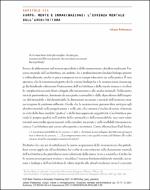Chapter Corpo, mente e immaginazione: l’essenza mentale dell’architettura
| dc.contributor.author | Pallasmaa, Juhani | |
| dc.date.accessioned | 2022-06-01T12:25:55Z | |
| dc.date.available | 2022-06-01T12:25:55Z | |
| dc.date.issued | 2021 | |
| dc.identifier | ONIX_20220601_9788855182867_685 | |
| dc.identifier.uri | https://library.oapen.org/handle/20.500.12657/56500 | |
| dc.description.abstract | In our culture, dominated by shallow rationality and reliance on the empirical, measur-able and demonstrable, the embodied, experiential and mental dimensions of design are supressed. Yet, there is an interest in the possibilities of neuroscience to reveal the roles of space, form, materiality, memory and imagery in our sensory experiences and mind. Neuroscience supports the mental objectives in design, which are in danger of being eliminated in the crudely rationalized, quantified and functionalized processes of de-sign. The task of architecture extends beyond its utilitarian purposes to the existential and mental sphere. Articulating lived existential space, architecture constitutes our sys-tem of externalized order, hierarchy, memory and meaning. Neuroscience will reveal how the external and internal, material and mental, utilitarian and poetic dimensions constitute an integrated existential experience. The interest in the mental dimensions of architecture will confirm the significance of intuition, empathy and imagination. | |
| dc.language | Italian | |
| dc.relation.ispartofseries | Ricerche. Architettura, Pianificazione, Paesaggio, Design | |
| dc.subject.other | embodiment | |
| dc.subject.other | memory | |
| dc.subject.other | empathy | |
| dc.subject.other | experience | |
| dc.subject.other | imagination | |
| dc.title | Chapter Corpo, mente e immaginazione: l’essenza mentale dell’architettura | |
| dc.type | chapter | |
| oapen.identifier.doi | 10.36253/978-88-5518-286-7.05 | |
| oapen.relation.isPublishedBy | bf65d21a-78e5-4ba2-983a-dbfa90962870 | |
| oapen.relation.isbn | 9788855182867 | |
| oapen.series.number | 6 | |
| oapen.pages | 21 | |
| oapen.place.publication | Florence |

